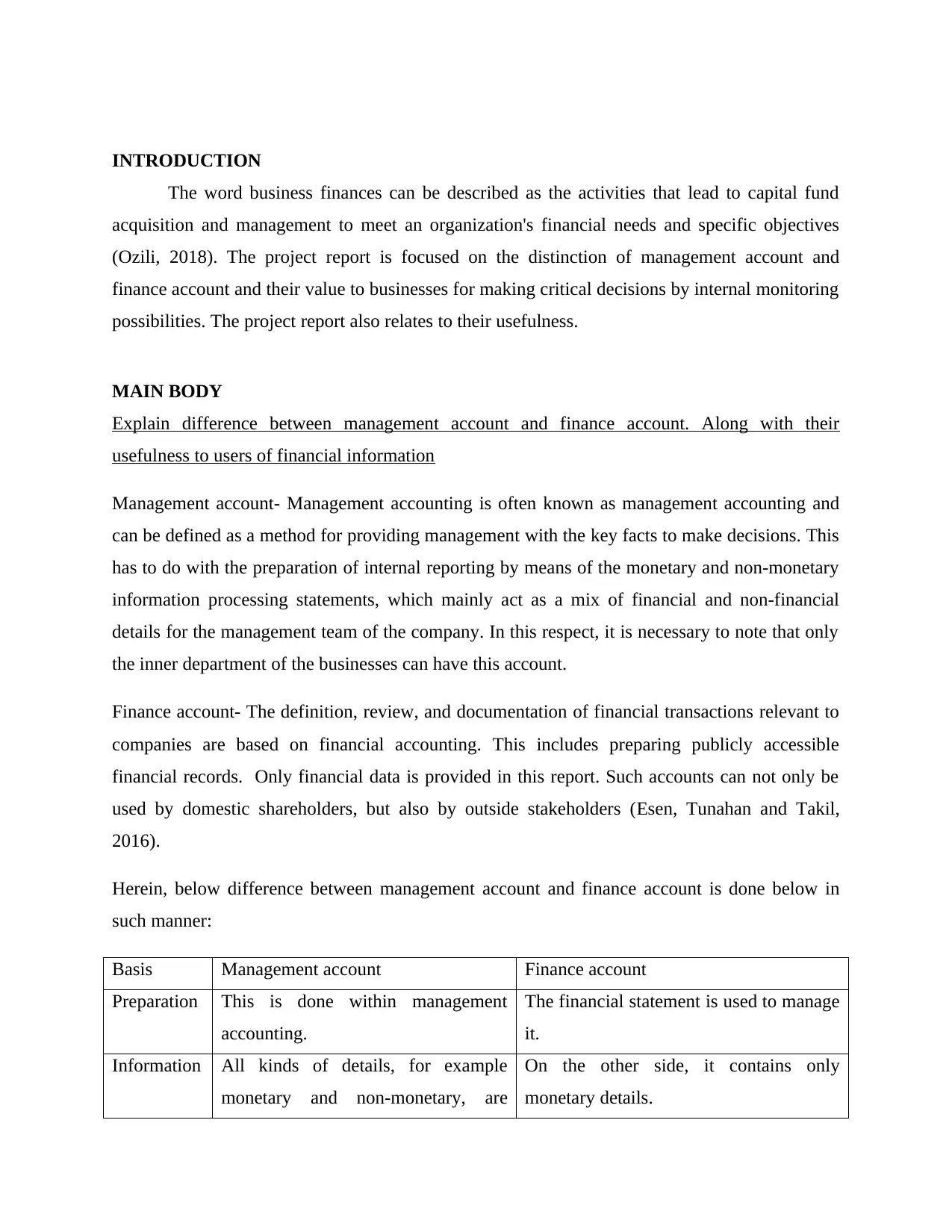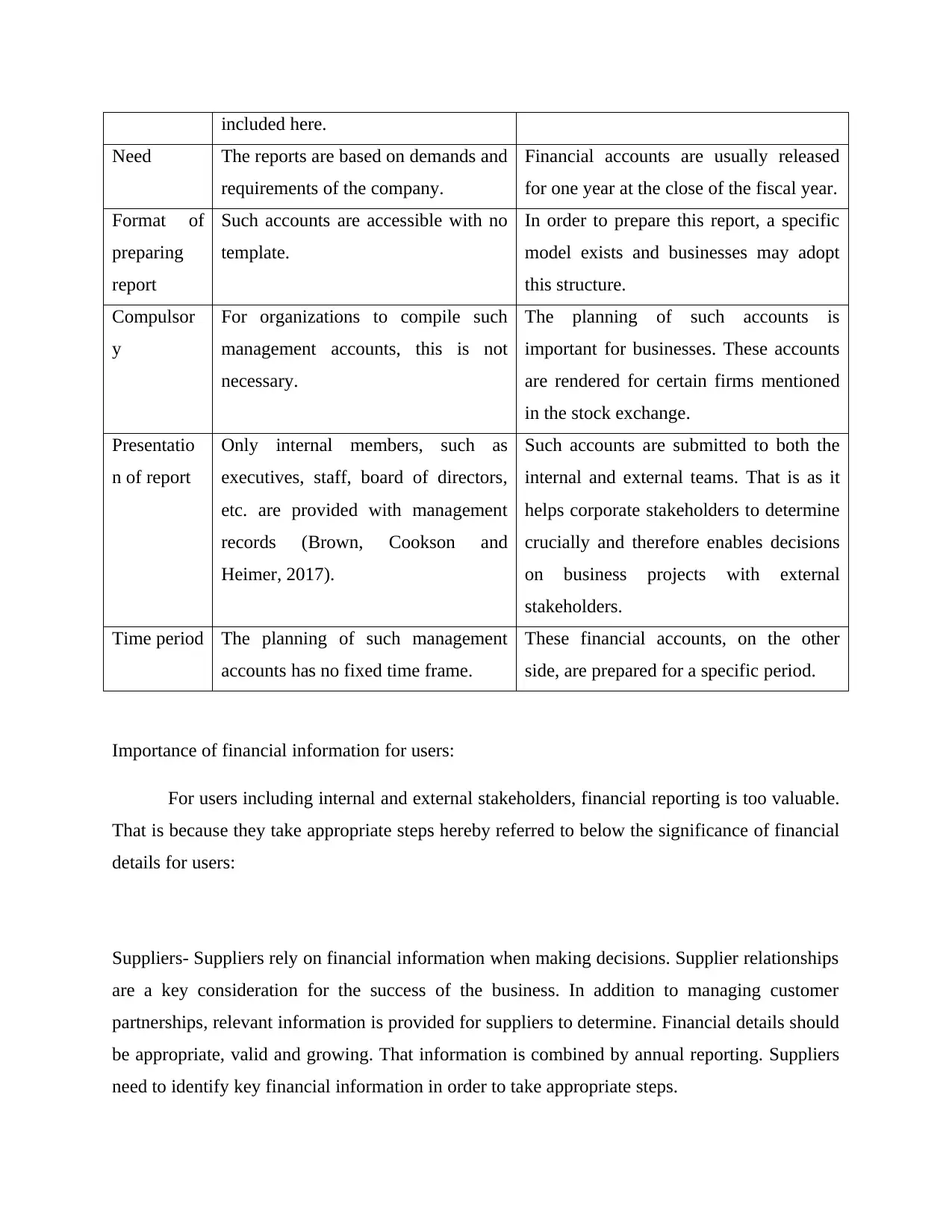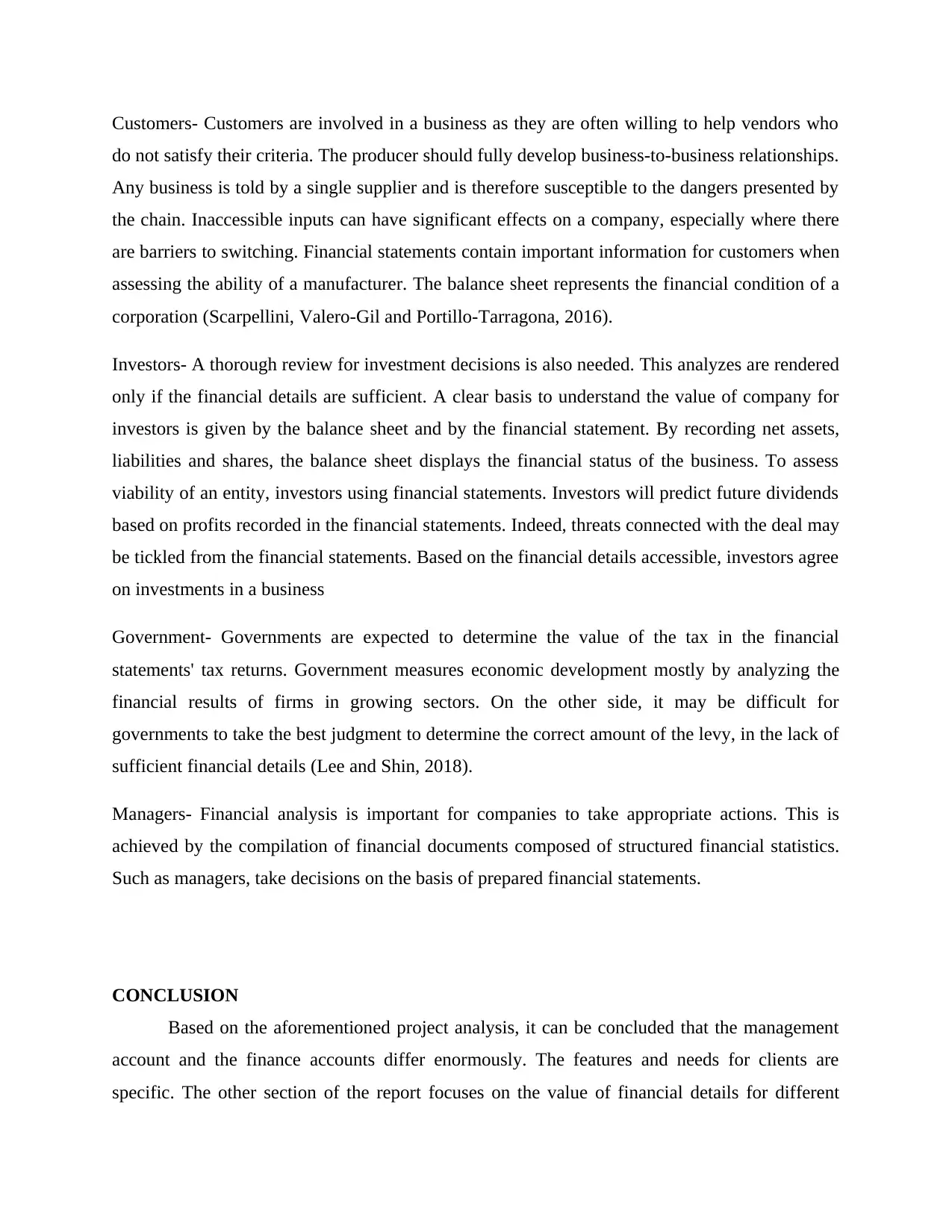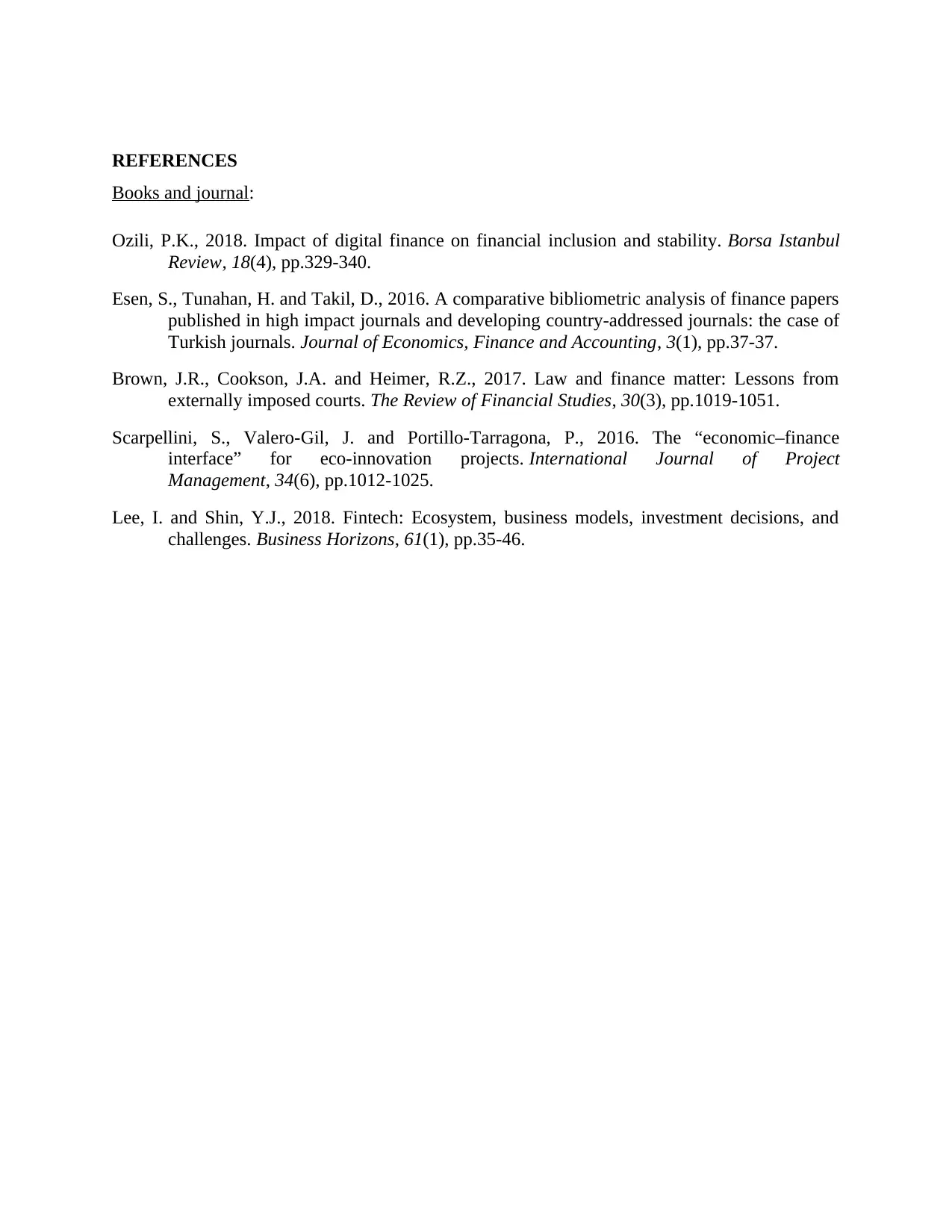Business Finance: Comparing Management and Financial Accounts Analysis
VerifiedAdded on 2023/01/11
|7
|1240
|34
Report
AI Summary
This business finance report delves into the core differences between management accounting and financial accounting, elucidating their distinct purposes and the information they provide. Management accounting, focused internally, aids in decision-making through the analysis of monetary and non-monetary data tailored to a company's specific needs, while financial accounting, directed externally, presents standardized financial statements for stakeholders. The report highlights the varying formats, timeframes, and users of each type of account, emphasizing how financial information is crucial for stakeholders such as suppliers, customers, investors, and government entities. It underscores how financial data enables informed decisions, from assessing a company's financial health to predicting future dividends and evaluating tax liabilities. Ultimately, the report stresses the significance of both accounting methods in supporting informed decision-making within and outside of a business.

BUSINESS FINANCE
Paraphrase This Document
Need a fresh take? Get an instant paraphrase of this document with our AI Paraphraser

Contents
INTRODUCTION...........................................................................................................................3
MAIN BODY..................................................................................................................................3
CONCLUSION................................................................................................................................5
REFERENCES................................................................................................................................6
INTRODUCTION...........................................................................................................................3
MAIN BODY..................................................................................................................................3
CONCLUSION................................................................................................................................5
REFERENCES................................................................................................................................6

INTRODUCTION
The word business finances can be described as the activities that lead to capital fund
acquisition and management to meet an organization's financial needs and specific objectives
(Ozili, 2018). The project report is focused on the distinction of management account and
finance account and their value to businesses for making critical decisions by internal monitoring
possibilities. The project report also relates to their usefulness.
MAIN BODY
Explain difference between management account and finance account. Along with their
usefulness to users of financial information
Management account- Management accounting is often known as management accounting and
can be defined as a method for providing management with the key facts to make decisions. This
has to do with the preparation of internal reporting by means of the monetary and non-monetary
information processing statements, which mainly act as a mix of financial and non-financial
details for the management team of the company. In this respect, it is necessary to note that only
the inner department of the businesses can have this account.
Finance account- The definition, review, and documentation of financial transactions relevant to
companies are based on financial accounting. This includes preparing publicly accessible
financial records. Only financial data is provided in this report. Such accounts can not only be
used by domestic shareholders, but also by outside stakeholders (Esen, Tunahan and Takil,
2016).
Herein, below difference between management account and finance account is done below in
such manner:
Basis Management account Finance account
Preparation This is done within management
accounting.
The financial statement is used to manage
it.
Information All kinds of details, for example
monetary and non-monetary, are
On the other side, it contains only
monetary details.
The word business finances can be described as the activities that lead to capital fund
acquisition and management to meet an organization's financial needs and specific objectives
(Ozili, 2018). The project report is focused on the distinction of management account and
finance account and their value to businesses for making critical decisions by internal monitoring
possibilities. The project report also relates to their usefulness.
MAIN BODY
Explain difference between management account and finance account. Along with their
usefulness to users of financial information
Management account- Management accounting is often known as management accounting and
can be defined as a method for providing management with the key facts to make decisions. This
has to do with the preparation of internal reporting by means of the monetary and non-monetary
information processing statements, which mainly act as a mix of financial and non-financial
details for the management team of the company. In this respect, it is necessary to note that only
the inner department of the businesses can have this account.
Finance account- The definition, review, and documentation of financial transactions relevant to
companies are based on financial accounting. This includes preparing publicly accessible
financial records. Only financial data is provided in this report. Such accounts can not only be
used by domestic shareholders, but also by outside stakeholders (Esen, Tunahan and Takil,
2016).
Herein, below difference between management account and finance account is done below in
such manner:
Basis Management account Finance account
Preparation This is done within management
accounting.
The financial statement is used to manage
it.
Information All kinds of details, for example
monetary and non-monetary, are
On the other side, it contains only
monetary details.
⊘ This is a preview!⊘
Do you want full access?
Subscribe today to unlock all pages.

Trusted by 1+ million students worldwide

included here.
Need The reports are based on demands and
requirements of the company.
Financial accounts are usually released
for one year at the close of the fiscal year.
Format of
preparing
report
Such accounts are accessible with no
template.
In order to prepare this report, a specific
model exists and businesses may adopt
this structure.
Compulsor
y
For organizations to compile such
management accounts, this is not
necessary.
The planning of such accounts is
important for businesses. These accounts
are rendered for certain firms mentioned
in the stock exchange.
Presentatio
n of report
Only internal members, such as
executives, staff, board of directors,
etc. are provided with management
records (Brown, Cookson and
Heimer, 2017).
Such accounts are submitted to both the
internal and external teams. That is as it
helps corporate stakeholders to determine
crucially and therefore enables decisions
on business projects with external
stakeholders.
Time period The planning of such management
accounts has no fixed time frame.
These financial accounts, on the other
side, are prepared for a specific period.
Importance of financial information for users:
For users including internal and external stakeholders, financial reporting is too valuable.
That is because they take appropriate steps hereby referred to below the significance of financial
details for users:
Suppliers- Suppliers rely on financial information when making decisions. Supplier relationships
are a key consideration for the success of the business. In addition to managing customer
partnerships, relevant information is provided for suppliers to determine. Financial details should
be appropriate, valid and growing. That information is combined by annual reporting. Suppliers
need to identify key financial information in order to take appropriate steps.
Need The reports are based on demands and
requirements of the company.
Financial accounts are usually released
for one year at the close of the fiscal year.
Format of
preparing
report
Such accounts are accessible with no
template.
In order to prepare this report, a specific
model exists and businesses may adopt
this structure.
Compulsor
y
For organizations to compile such
management accounts, this is not
necessary.
The planning of such accounts is
important for businesses. These accounts
are rendered for certain firms mentioned
in the stock exchange.
Presentatio
n of report
Only internal members, such as
executives, staff, board of directors,
etc. are provided with management
records (Brown, Cookson and
Heimer, 2017).
Such accounts are submitted to both the
internal and external teams. That is as it
helps corporate stakeholders to determine
crucially and therefore enables decisions
on business projects with external
stakeholders.
Time period The planning of such management
accounts has no fixed time frame.
These financial accounts, on the other
side, are prepared for a specific period.
Importance of financial information for users:
For users including internal and external stakeholders, financial reporting is too valuable.
That is because they take appropriate steps hereby referred to below the significance of financial
details for users:
Suppliers- Suppliers rely on financial information when making decisions. Supplier relationships
are a key consideration for the success of the business. In addition to managing customer
partnerships, relevant information is provided for suppliers to determine. Financial details should
be appropriate, valid and growing. That information is combined by annual reporting. Suppliers
need to identify key financial information in order to take appropriate steps.
Paraphrase This Document
Need a fresh take? Get an instant paraphrase of this document with our AI Paraphraser

Customers- Customers are involved in a business as they are often willing to help vendors who
do not satisfy their criteria. The producer should fully develop business-to-business relationships.
Any business is told by a single supplier and is therefore susceptible to the dangers presented by
the chain. Inaccessible inputs can have significant effects on a company, especially where there
are barriers to switching. Financial statements contain important information for customers when
assessing the ability of a manufacturer. The balance sheet represents the financial condition of a
corporation (Scarpellini, Valero-Gil and Portillo-Tarragona, 2016).
Investors- A thorough review for investment decisions is also needed. This analyzes are rendered
only if the financial details are sufficient. A clear basis to understand the value of company for
investors is given by the balance sheet and by the financial statement. By recording net assets,
liabilities and shares, the balance sheet displays the financial status of the business. To assess
viability of an entity, investors using financial statements. Investors will predict future dividends
based on profits recorded in the financial statements. Indeed, threats connected with the deal may
be tickled from the financial statements. Based on the financial details accessible, investors agree
on investments in a business
Government- Governments are expected to determine the value of the tax in the financial
statements' tax returns. Government measures economic development mostly by analyzing the
financial results of firms in growing sectors. On the other side, it may be difficult for
governments to take the best judgment to determine the correct amount of the levy, in the lack of
sufficient financial details (Lee and Shin, 2018).
Managers- Financial analysis is important for companies to take appropriate actions. This is
achieved by the compilation of financial documents composed of structured financial statistics.
Such as managers, take decisions on the basis of prepared financial statements.
CONCLUSION
Based on the aforementioned project analysis, it can be concluded that the management
account and the finance accounts differ enormously. The features and needs for clients are
specific. The other section of the report focuses on the value of financial details for different
do not satisfy their criteria. The producer should fully develop business-to-business relationships.
Any business is told by a single supplier and is therefore susceptible to the dangers presented by
the chain. Inaccessible inputs can have significant effects on a company, especially where there
are barriers to switching. Financial statements contain important information for customers when
assessing the ability of a manufacturer. The balance sheet represents the financial condition of a
corporation (Scarpellini, Valero-Gil and Portillo-Tarragona, 2016).
Investors- A thorough review for investment decisions is also needed. This analyzes are rendered
only if the financial details are sufficient. A clear basis to understand the value of company for
investors is given by the balance sheet and by the financial statement. By recording net assets,
liabilities and shares, the balance sheet displays the financial status of the business. To assess
viability of an entity, investors using financial statements. Investors will predict future dividends
based on profits recorded in the financial statements. Indeed, threats connected with the deal may
be tickled from the financial statements. Based on the financial details accessible, investors agree
on investments in a business
Government- Governments are expected to determine the value of the tax in the financial
statements' tax returns. Government measures economic development mostly by analyzing the
financial results of firms in growing sectors. On the other side, it may be difficult for
governments to take the best judgment to determine the correct amount of the levy, in the lack of
sufficient financial details (Lee and Shin, 2018).
Managers- Financial analysis is important for companies to take appropriate actions. This is
achieved by the compilation of financial documents composed of structured financial statistics.
Such as managers, take decisions on the basis of prepared financial statements.
CONCLUSION
Based on the aforementioned project analysis, it can be concluded that the management
account and the finance accounts differ enormously. The features and needs for clients are
specific. The other section of the report focuses on the value of financial details for different

categories of customers, both internally and externally, such as government, clients and several
others. Each has an interest in client financial details.
others. Each has an interest in client financial details.
⊘ This is a preview!⊘
Do you want full access?
Subscribe today to unlock all pages.

Trusted by 1+ million students worldwide

REFERENCES
Books and journal:
Ozili, P.K., 2018. Impact of digital finance on financial inclusion and stability. Borsa Istanbul
Review, 18(4), pp.329-340.
Esen, S., Tunahan, H. and Takil, D., 2016. A comparative bibliometric analysis of finance papers
published in high impact journals and developing country-addressed journals: the case of
Turkish journals. Journal of Economics, Finance and Accounting, 3(1), pp.37-37.
Brown, J.R., Cookson, J.A. and Heimer, R.Z., 2017. Law and finance matter: Lessons from
externally imposed courts. The Review of Financial Studies, 30(3), pp.1019-1051.
Scarpellini, S., Valero-Gil, J. and Portillo-Tarragona, P., 2016. The “economic–finance
interface” for eco-innovation projects. International Journal of Project
Management, 34(6), pp.1012-1025.
Lee, I. and Shin, Y.J., 2018. Fintech: Ecosystem, business models, investment decisions, and
challenges. Business Horizons, 61(1), pp.35-46.
Books and journal:
Ozili, P.K., 2018. Impact of digital finance on financial inclusion and stability. Borsa Istanbul
Review, 18(4), pp.329-340.
Esen, S., Tunahan, H. and Takil, D., 2016. A comparative bibliometric analysis of finance papers
published in high impact journals and developing country-addressed journals: the case of
Turkish journals. Journal of Economics, Finance and Accounting, 3(1), pp.37-37.
Brown, J.R., Cookson, J.A. and Heimer, R.Z., 2017. Law and finance matter: Lessons from
externally imposed courts. The Review of Financial Studies, 30(3), pp.1019-1051.
Scarpellini, S., Valero-Gil, J. and Portillo-Tarragona, P., 2016. The “economic–finance
interface” for eco-innovation projects. International Journal of Project
Management, 34(6), pp.1012-1025.
Lee, I. and Shin, Y.J., 2018. Fintech: Ecosystem, business models, investment decisions, and
challenges. Business Horizons, 61(1), pp.35-46.
1 out of 7
Related Documents
Your All-in-One AI-Powered Toolkit for Academic Success.
+13062052269
info@desklib.com
Available 24*7 on WhatsApp / Email
![[object Object]](/_next/static/media/star-bottom.7253800d.svg)
Unlock your academic potential
Copyright © 2020–2025 A2Z Services. All Rights Reserved. Developed and managed by ZUCOL.





